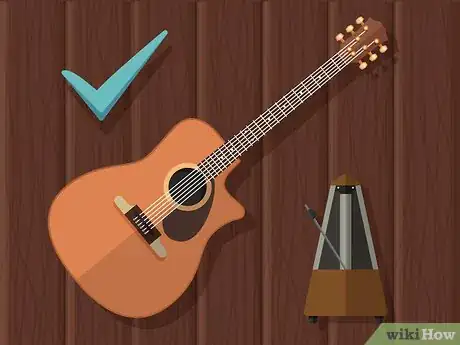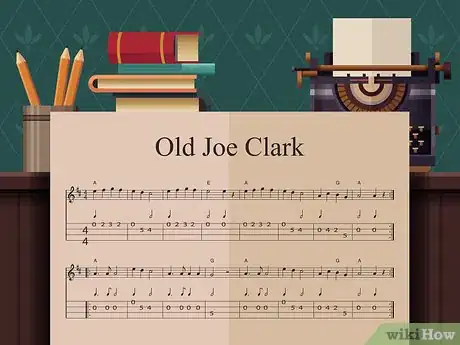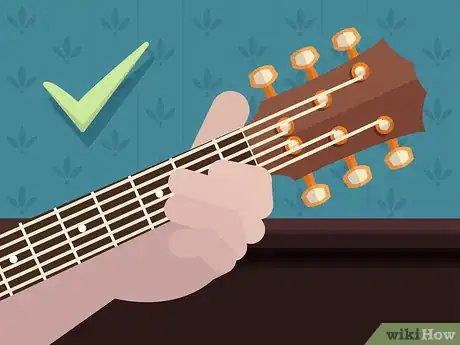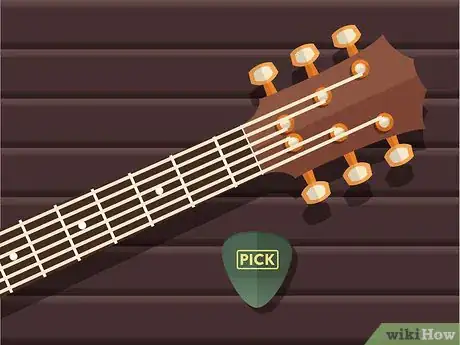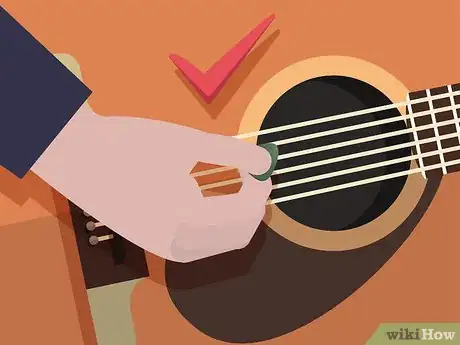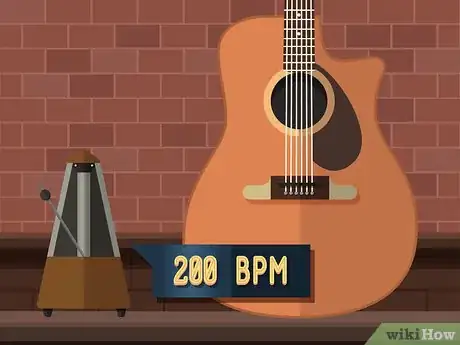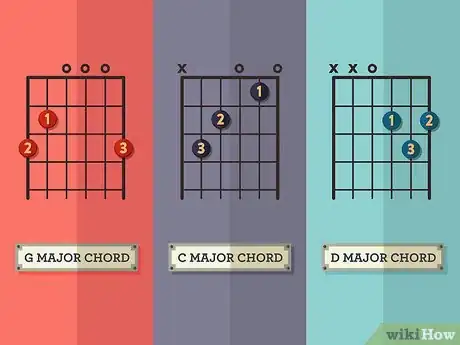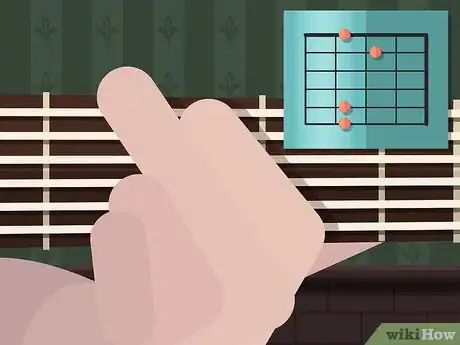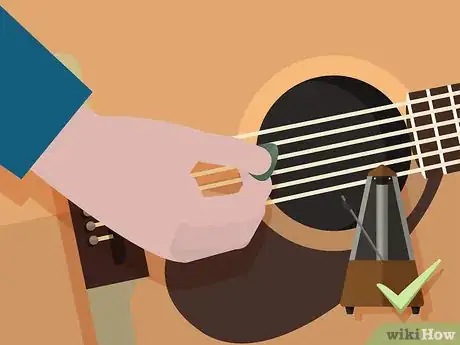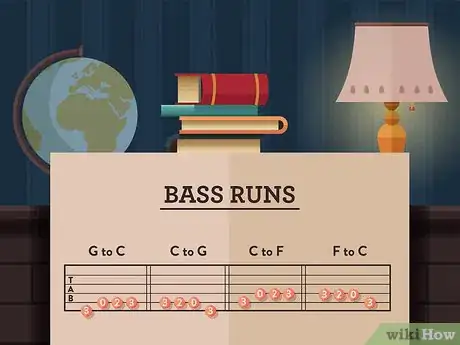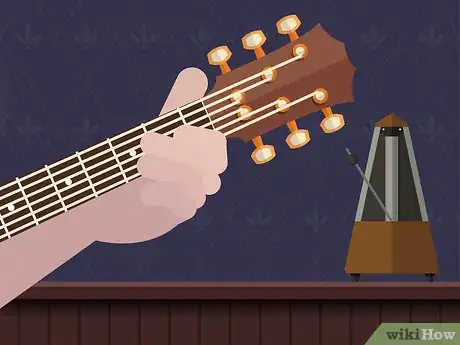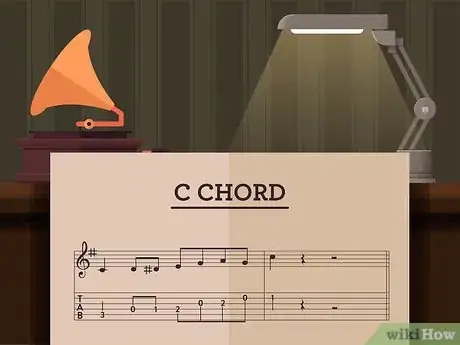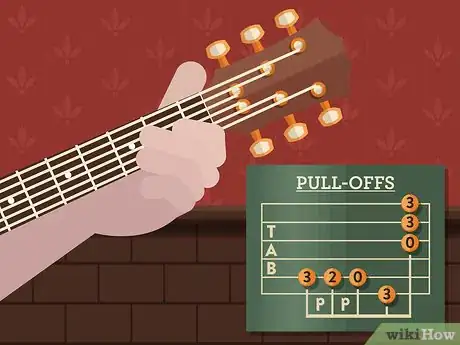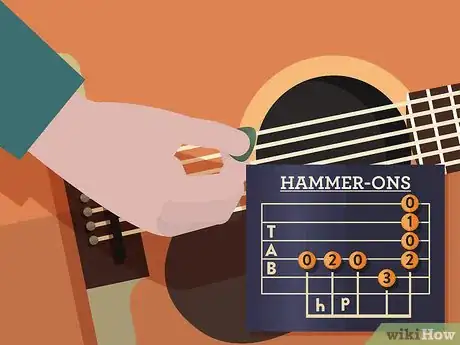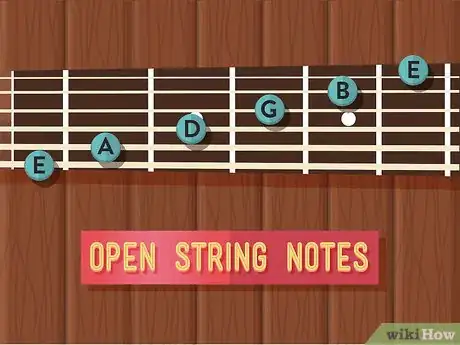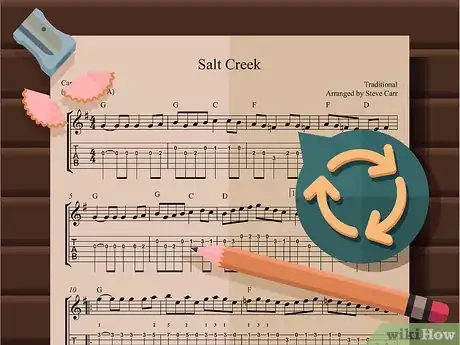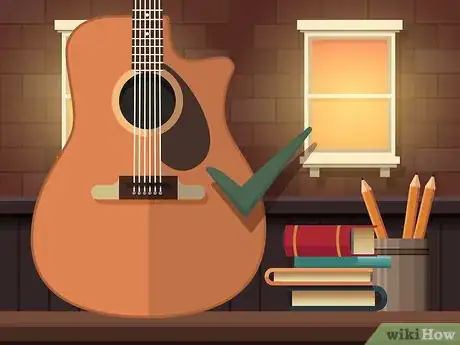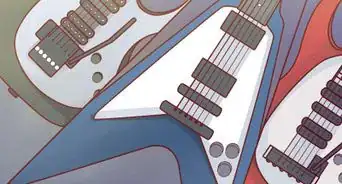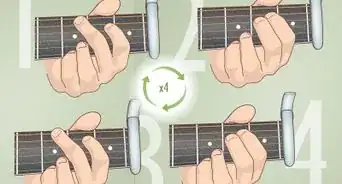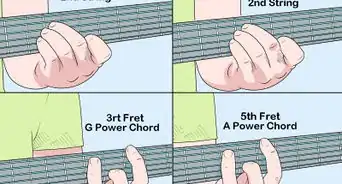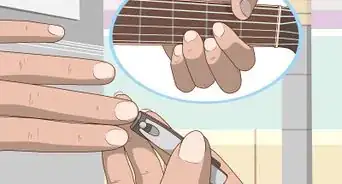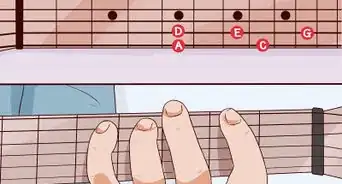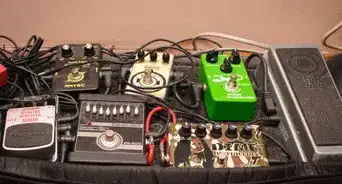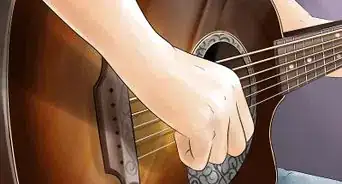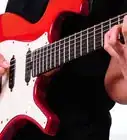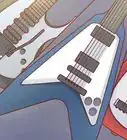This article was co-authored by Carlos Alonzo Rivera, MA. Carlos Alonzo Rivera is a guitarist, composer, and educator based in San Francisco, California. He holds a Bachelor of Arts degree in Music from California State University, Chico, as well as a Master of Music degree in Classical Guitar Performance from the San Francisco Conservatory of Music. Carlos specializes in the following genres: classical, jazz. rock, metal and blues.
There are 12 references cited in this article, which can be found at the bottom of the page.
This article has been viewed 30,896 times.
Bluegrass guitar is a blisteringly fast, highly technical art form that, paradoxically, almost anyone can learn. That's because the theory and chords behind bluegrass guitar are relatively simple, even if they don't seem like it at full pace. What takes some time is getting up to speed, but even that is within anyone's reach with some dedicated practice and pro tips.
Steps
Learning the Basics
-
1Master a metronome-perfect sense of rhythm. Most of your time on the guitar is going to be spent playing rhythm sections, not soloing, and an one-the-money sense of rhythm is what distinguishes a great bluegrass guitarist from a beginner. Whenever you practice, you should be using a metronome the majority of the time.
- Set the metronome to a speed where you can play everything perfectly, slowly raising the tempo from there. You want to play smoothly at any speed -- not quickly by sloppily.
- Bluegrass gains power and drive when every single instrument is locked into the same rhythm. It quickly sounds sloppy when some people are too fast or are lagging behind.[1]
-
2Learn the bluegrass standards. Most bluegrass guitar is played communally with other guitarists, banjoist, mandolins, etc, and the only way these circles work is if everyone knows the same songs. Don't be afraid to ask other musicians for suggestions, too. Pick up these classics and master them first to start playing with other musicians and build your repertoire:
- "Salt Creek"
- "Fireball Mail"
- "Old Joe Clark"
- "Whiskey Before Breakfast"
- "Angeline the Baker."[2]
Advertisement -
3Keep both hands loose and relaxed, especially in speedy sections. You want a light touch on the strings, using as little pressure as possible to let the note ring out. Many players tense up when trying to play fast, which binds their muscles and prevents fluidity and speed. Don't worry if your touch feels "heavy" right now. Make it a point to loosen up on the guitar and you'll slowly start to feel faster and smoother.
- A good tip is to keep your fingers close to the fretboard, even when not playing a note. This cuts down on the speed and force you need to land on a note.[3]
-
4Play with pick placement to get different tones and attacks on the strings. Most players start with their pick perfectly parallel to the strings, as this is the easiest way to get solid contact. Bluegrass players, however, use a wide variety of picking textures to get more rhythmic aspects into their play. As a right-handed player, rotate your hand clockwise a few degrees to hit the strings more on the edge of the pick, which should be sharper and more percussive. If you pick with the left hand, turn counter-clockwise.[4]
-
5Take short, precise strums instead of using big and expansive motions. Bluegrass is not the place to whip out your Pete Townsend impression with big, windmilling strums. You want a short, powerful swing with your strumming hand. Think of driving your pick through the strings instead of over top them.
- This is a place your pick placement can help get a louder tone with a shorter strum. The harsher the angle, the louder the chord.[5]
-
6Build up your playing speed slowly, deliberately, and smoothly. Bluegrass is a very fast genre of music, almost never dropping below 200 beats per minute (BPM). This means playing fast isn't just nice, it's a requirement. In order to play quickly, however, you need some patience. All the speed in the world doesn't matter if you can't hit the notes cleanly.
- Practice at a speed just above your comfort level, and don't increase the speed until you can hit this tempo cleanly every time.
- Again, the use of a metronome cannot be understated -- it is necessary for consistent rhythm.[6]
Playing Bluegrass Rhythms
-
1Learn as many of the open chords and chord shapes as you can. Open chords are those that utilize unfretted, or "open," notes when played. They are far and away the most common chords in bluegrass, as open notes will keep ringing out after being played, which creates wonderful sustain and lasting melody. If you're just starting, the essentials are C, G, and D, which can form hundreds of songs on their own:
- C-Chord | G-Chord | D-Chord |
- |e|----x-----|------3------|-----2------|
- |B|----1----|------3------|-----3------|
- |G|----0----|------0------|-----2------|
- |D|----2----|------0------|-----0------|
- |A|----3----|------2------|-----x------|
- |E|----x----|------3------|-----x------|[7]
-
2Learn the "boom & chick" pattern most common in bluegrass rhythm guitar. This is the classic and most essential bluegrass rhythm, and can be played on any chord. Start with an open G, fingering it like normal, and count out a basic "1, 2, 3, 4 / 1, 2, 3, 4/ etc." rhythm, using a metronome to help keep time.[8]
- Beat 1: Pluck the root note, in this case the 6th string, 3rd fret.
- Beat 2: Strum the bottom 3-4 strings of the cord, coming up with the pick.
- Beat 3: Pluck 4th string note of the chord, in this case the open D string.
- Beat 4: Strum the bottom 3-4 strings of the chord, coming up with the pick.[9]
-
3Lay additional emphasis on the second and forth beats to really swing. This means, if playing your basic "boom-chick," you're leaning a little harder on the strummed notes than the chords. This provides a regular rhythmic backbone to the song, not unlike the "lub-DUB" of your heartbeat. Other instruments, in general, will fill the other spaces in the rhythm with their own emphasis.
- This frequently means emphasizing your upstroke while picking. A solid, strong upstroke will usually give a song a swinging feel.
- Remember that musical tension is created through contrast. By keeping beats 1 & 3 relaxed, you get a little added power in beats 2 & 4.[10]
-
4Use "bass runs" to add little licks of flavor between chords. A bass run is simply a set of single notes, played on the heavier strings, that you use to transition from one chord or song section to the other. You can look up thousands of them online, but the basic strategy is to just "walk" from the bass note of one chord to the bass note of the other chord, playing some of the frets in between to get there. One simple example of a "G-run" would be like this -- starting with the classic "boom-chick" on a G chord and moving to C with a few solo notes. The "run" is in the 4th & 5th bar:
- |e|-------3---|-------3----|------3------|------------|--------0----|
- |B|------3---|-------3-----|-----3------|-------------|-------1-----|
- |G|------0---|-------0----|------0------|------------|--------0----|
- |D|-----------|-0----------|-------------|-------------|-------2-----|
- |A|-----------|-------------|-------------|---0--2----|--3----------|
- |E|--3-------|-------------|--3---------|-------------|-------------|[11]
-
5Provide a rock-solid perfect rhythmic backing before moving on to lead play. Before taking any bass runs or fine-tuning your pick position, you must have perfect rhythm. The guitar, with it's big, rich sound and natural volume, often takes the duty of a drummer in a bluegrass circle. As the guitarist, your job is to keep everyone on time. None of your technical flash matters if you can't hold down the tempo.
- This is why you must practice with a metronome. It is the only way to train and ensure perfect rhythm each time.[12]
Playing Bluegrass Lead Guitar
-
1Use the notes from your chords to build your basic lead lines. Because bluegrass guitarists must be able to quickly transition from lead lines to rhythmic playing, as evidenced briefly in the bass runs above, they tend to use similar sets of notes to make speedy play much easier. Use the notes from each chord currently being played to form your licks and solos. For example, the following lick in the key of C only uses those open notes and notes already in a C chord:
- |e|----------------------------------------------------|
- |B|------------------------------0---1---------------|
- |G|---------------------0--2-------------------------|
- |D|---------0--1--2---------------------------------|
- |A|----3----------------------------------------------|
- |E|----------------------------------------------------|[13]
-
2Use pull-offs to pluck open strings without having to pick. Instead of gently removing your finger from the fret, pull it downward, sounding out the string like your finger was a pick. Because bluegrass relies so much on open strings, this is a great way to quickly ring them out while picking other notes, effectively doubling your playing speed. Check out this simple run from a C to a G to see it in action -- the "p" means to pull off the first note into the second:
- |e|---------------------3---|
- |B|--------------------3--|
- |G|--------------------0---|
- |D|-------------------------|
- |A|----3p2p0-------------|
- |E|---------------3---------|
-
3Use hammer-ons to quickly blaze up the fretboard. A hammer on is when you slam your finger down on the fret so that it sounds out without picking. They are a great way to add subtle notes to your lead lines and solos and increase note speed. They also pair excellently with pull-offs, which can allow you to play three notes with only one strum. The "h" means you hammer onto the fret immediately after the "h":
- |e|---------------------0----|
- |B|--------------------1----|
- |G|--------------------0----|
- |D|----0h2p0--------2----|
- |A|---------------3----------|
- |E|--------------------------|
-
4Use open notes whenever you're in doubt, especially with pull-offs. A great way to increase your picking speed is to pick notes with your fretting hand. Hammer-ons and pull-offs are essential for bluegrass play, as they add speed and texture only possible with open notes, so don't be afraid to just start plucking and pulling off your chords to transition in and out of solos or create a little extra rhythm to your solos.
-
5Use repeated notes instead of trying to dance around the fretboard with fast songs. For beginners, playing a lead line at a blistering 240BPM is a recipe for crashing and burning. A good way to get up to that pace is not to play as many different notes as you can, but to focus on playing a few notes well. You can keep your picking hand moving while keeping things simple on the fretboard, allowing you to play blazing fast lines with less effort. Try doubling or tripling up notes before you move, giving you a bit more time to think.
- As you get better, you'll be able to start picking and fretting at faster and faster speeds -- just remember that it doesn't matter how fast a solo is if it sounds sloppy.
-
6Use the major and minor pentatonic scales to start working your way down the neck. Most solos, as evidenced above, tend to stick to the top of the guitar. But if you're really serious about lead guitar then you already want to stretch further down the neck into new territory. Luckily, the most common guitar scales -- the major and minor pentatonic scale -- will work wonders.[14]
- A common, but difficult, skill is to change the scale to match the chord being played. So, for an A chord, you play the A-major pentatonic, then move to the C-major when switching to the C chord. This requires in-depth knowledge of every note on the fretboard.
- If you're serious about bluegrass guitar, you must spend time learning the music theory behind the CAGED system, which helps map the fretboard.[15]
- Still feel like stretching your musical muscles? Dive into the mixolydian mode for bluegrass solos as well.[16]
Expert Q&A
-
QuestionWhat scales should I learn for blues?
 Carlos Alonzo Rivera, MACarlos Alonzo Rivera is a guitarist, composer, and educator based in San Francisco, California. He holds a Bachelor of Arts degree in Music from California State University, Chico, as well as a Master of Music degree in Classical Guitar Performance from the San Francisco Conservatory of Music. Carlos specializes in the following genres: classical, jazz. rock, metal and blues.
Carlos Alonzo Rivera, MACarlos Alonzo Rivera is a guitarist, composer, and educator based in San Francisco, California. He holds a Bachelor of Arts degree in Music from California State University, Chico, as well as a Master of Music degree in Classical Guitar Performance from the San Francisco Conservatory of Music. Carlos specializes in the following genres: classical, jazz. rock, metal and blues.
Professional Guitarist Learn a blues pentatonic scale. Use that as a vehicle to improvise on. You can play E minor blues pentatonic scale, and any note in that scale will fit and sound good over E blues.
Learn a blues pentatonic scale. Use that as a vehicle to improvise on. You can play E minor blues pentatonic scale, and any note in that scale will fit and sound good over E blues.
Things You'll Need
- An acoustic guitar
- Metronome
- Tuner
References
- ↑ http://www.bluegrassguitar.com/learningtips.html
- ↑ http://www.premierguitar.com/articles/23404-commandments-of-bluegrass-guitar
- ↑ http://www.premierguitar.com/articles/23404-commandments-of-bluegrass-guitar
- ↑ http://www.premierguitar.com/articles/23404-commandments-of-bluegrass-guitar
- ↑ http://www.bluegrassguitar.com/learningtips.html
- ↑ http://www.flatpickingtabs.com/scalesstuff.htm
- ↑ http://www.bluegrassguitar.com/rhythm.html
- ↑ http://www.guitarlessons.com/guitar-lessons/guitar-styles/basic-bluegrass-strumming/
- ↑ http://www.flatpickingtabs.com/scalesstuff.htm
- ↑ http://www.bluegrassguitar.com/rhythm.html
- ↑ http://www.bluegrassguitar.com/pdf/RhythmExercise_G.pdf
- ↑ http://www.bluegrassguitar.com/rhythm.html
- ↑ http://guitarcompass.com/free-lessons/bluegrass/improv-licks/
- ↑ http://www.bluegrassguitaressentials.com/pentatonic-scale/
- ↑ https://pegheadnation.com/string-school/courses/roots-and-bluegrass-rhythm-guitar/
- ↑ http://www.guitarcoaching.com/learnguitararticles/Bluegrass.htm
